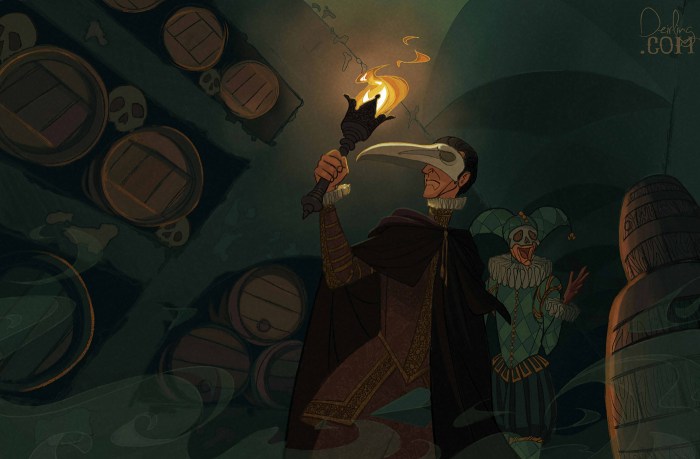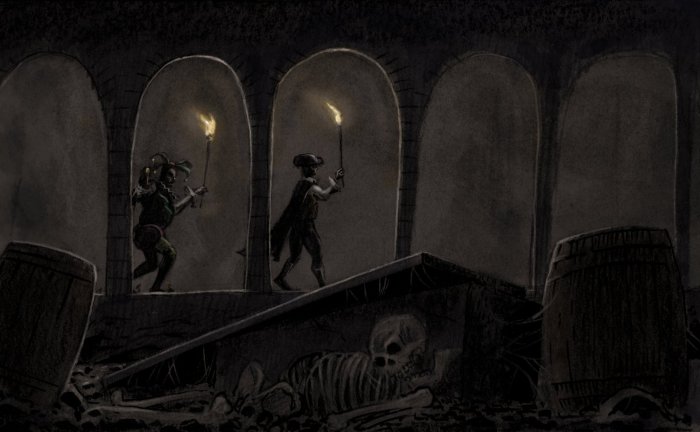The cask of amontillado e.g. – In the eerie catacombs beneath the vibrant streets of Italy, The Cask of Amontillado unfolds a chilling tale of vengeance and deceit. Follow Montresor, a man consumed by a thirst for revenge, as he lures his unsuspecting victim, Fortunato, into a labyrinth of darkness and despair.
Prepare for a riveting journey through the twisted minds of these unforgettable characters, where the boundaries of sanity blur, and the consequences of unchecked rage reverberate through the corridors of time.
Plot Summary
The Cask of Amontillado is a short story by Edgar Allan Poe, first published in 1846. It tells the tale of Montresor, who seeks revenge against his former friend Fortunato for an unspecified insult.
Montresor lures Fortunato into his catacombs, claiming to have discovered a rare cask of Amontillado wine. As they descend deeper into the catacombs, Montresor chains Fortunato to a wall and begins to brick him up alive. Fortunato initially believes it is a joke, but as Montresor continues to wall him in, he realizes the true nature of his situation.
Fortunato’s cries for help go unanswered as Montresor finishes walling him up. Montresor leaves Fortunato to die a slow and agonizing death, satisfied that he has finally gotten his revenge.
Central Conflict
The central conflict of the story is between Montresor and Fortunato. Montresor seeks revenge against Fortunato for an unspecified insult, while Fortunato is unaware of Montresor’s intentions and believes they are simply going to taste some wine.
Resolution
The conflict is resolved when Montresor walls Fortunato up alive in the catacombs. Fortunato’s cries for help go unanswered, and he dies a slow and agonizing death. Montresor is satisfied that he has finally gotten his revenge.
Characters

The Cask of Amontillado features two main characters: Montresor and Fortunato. Their contrasting personalities and motivations drive the plot and create a complex and suspenseful atmosphere.
Montresor
Montresor is the narrator and protagonist of the story. He is a wealthy and respected member of the Italian nobility, but he harbors a deep-seated grudge against Fortunato. Montresor is cunning, calculating, and vengeful. He plans his revenge meticulously, luring Fortunato into his catacombs under the pretense of tasting a rare wine.
Fortunato
Fortunato is a wealthy and eccentric wine connoisseur. He is arrogant, boastful, and oblivious to Montresor’s true intentions. Fortunato’s love of wine and his desire to impress Montresor make him an easy target for Montresor’s revenge. As the story progresses, Fortunato’s initial confidence turns into fear and desperation as he realizes the true nature of Montresor’s plan.
Relationship
Montresor and Fortunato have a complex and ambivalent relationship. They are both members of the same social class, but their personalities and motivations are vastly different. Montresor despises Fortunato for an unspecified insult, while Fortunato is unaware of Montresor’s animosity and treats him with a mixture of condescension and familiarity.
Setting

Edgar Allan Poe’s “The Cask of Amontillado” is set in the catacombs beneath an unnamed Italian city during the Carnival season in the 19th century. The atmosphere is one of mystery, suspense, and terror.
The catacombs are a labyrinth of dark, narrow tunnels and chambers. The air is cold and damp, and the walls are lined with bones and skulls. The only light comes from flickering torches, which cast eerie shadows on the walls.
The Catacombs
The catacombs are a central part of the story. They provide the setting for the murder and they create a sense of claustrophobia and isolation. The darkness and the bones and skulls are constant reminders of death.
The Cask of Amontillado is a classic tale of revenge, but it also raises some interesting questions about chemistry. For example, is nash a strong nucleophile? A nucleophile is a chemical species that donates electrons to another species, and nash is a type of nucleophile that is often used in organic chemistry.
To learn more about the strength of nash as a nucleophile, you can check out this article: is nash a strong nucleophile . Back to the Cask of Amontillado, the story’s protagonist, Montresor, uses his knowledge of chemistry to exact revenge on his enemy, Fortunato.
The catacombs also symbolize the darkness and evil that lurks beneath the surface of society. Montresor uses the catacombs to hide his crime, and the bones and skulls represent the victims of his cruelty.
Themes

Edgar Allan Poe’s “The Cask of Amontillado” delves into several profound themes that explore the complexities of human nature and societal norms.
The central theme revolves around the destructive power of revenge. Montresor’s elaborate plan to seek vengeance against Fortunato reveals the depths of his resentment and the lengths he is willing to go to satisfy his desire for retribution. Through this theme, Poe highlights the corrosive effects of hatred and the dangers of allowing it to consume one’s life.
Symbolism and Imagery
Poe employs powerful symbolism and imagery to reinforce the story’s themes. The setting of the catacombs, with its dark and claustrophobic atmosphere, represents the psychological depths to which Montresor descends in his pursuit of revenge.
The cask of Amontillado, a symbol of Fortunato’s indulgence and vanity, becomes a vessel of Montresor’s vengeance. As Montresor chains Fortunato to the wall and buries him alive, the cask becomes a metaphor for the prison of his own hatred.
Literary Devices: The Cask Of Amontillado E.g.
The “Cask of Amontillado” masterfully employs literary devices to create a haunting and unforgettable experience for readers. Foreshadowing, irony, and suspense intertwine throughout the story, contributing significantly to its overall impact.
Foreshadowing
Foreshadowing is used to subtly hint at events that will occur later in the story. In the “Cask of Amontillado,” Montresor’s initial description of the catacombs as “a succession of vast, low, and vaulted chambers” foreshadows the claustrophobic and oppressive setting where the gruesome murder will take place.
Irony
Irony is a contrast between what is expected and what actually happens. In the story, Montresor’s insistence on revenge against Fortunato is ironic because it ultimately leads to his own downfall. The irony deepens when Montresor imprisons Fortunato in the catacombs, a place intended for the dead but now housing the living.
Suspense
Suspense is created through the gradual revelation of information and the building tension. Montresor’s meticulous planning and Fortunato’s obliviousness create a sense of anticipation and dread. The reader is kept on edge, wondering what will happen to Fortunato and how Montresor will carry out his revenge.
Cultural and Historical Context
Edgar Allan Poe’s “The Cask of Amontillado” was written in the mid-19th century, a period marked by significant social and cultural changes in the United States. The story reflects the prevailing values and beliefs of the time, including a fascination with the macabre, a preoccupation with death and decay, and a belief in the importance of honor and revenge.
Values and Beliefs
The story’s protagonist, Montresor, is driven by a desire for revenge against Fortunato, who he believes has wronged him. This emphasis on revenge reflects the code of honor that was prevalent in the antebellum South, where duels and other forms of violence were often seen as necessary to restore one’s reputation.
Relevance to Contemporary Society
While the story’s setting and characters are rooted in the 19th century, its themes of revenge, guilt, and the fragility of human relationships remain relevant to contemporary society. The story serves as a cautionary tale about the dangers of allowing one’s emotions to control one’s actions and the importance of forgiveness and reconciliation.
Critical Reception

Edgar Allan Poe’s “The Cask of Amontillado” has received critical acclaim since its publication in 1846. Critics have praised the story’s suspenseful plot, atmospheric setting, and complex characters.
One of the most striking aspects of the story is its suspense. Poe creates a sense of dread and anticipation from the very beginning, and the tension only builds as the story progresses. Readers are kept on the edge of their seats as they wait to see what will happen to Montresor and Fortunato.
Story’s Enduring Popularity
There are several reasons for the story’s enduring popularity. First, it is a well-crafted story with a strong plot and interesting characters. Second, the story’s themes of revenge and madness are universal, and they continue to resonate with readers today.
Finally, the story’s atmospheric setting and suspenseful plot make it a truly immersive experience.
Influence on Other Works
“The Cask of Amontillado” has had a significant influence on other works of literature and popular culture. The story has been adapted into films, television shows, and operas. It has also been referenced in other works of literature, such as Stephen King’s “The Shining” and Umberto Eco’s “The Name of the Rose.”
Adaptations

The Cask of Amontillado has been adapted into numerous films, television shows, and theater productions. These adaptations have varied in their faithfulness to the original story, but all have sought to capture the tale’s suspense and horror.
Film Adaptations
One of the most famous film adaptations of The Cask of Amontillado is Roger Corman’s 1964 film of the same name. This film stars Vincent Price as Montresor and Peter Lorre as Fortunato. The film is generally faithful to the original story, but it does make some changes, such as adding a backstory for Montresor and Fortunato.Another
notable film adaptation of The Cask of Amontillado is Luis Buñuel’s 1972 film Viridiana. This film is a loose adaptation of the story, but it uses the basic plot to explore themes of religion, sexuality, and violence.
Television Adaptations
The Cask of Amontillado has also been adapted into several television shows. One of the most famous is an episode of the television series Alfred Hitchcock Presents, which aired in 1956. This episode stars Steve McQueen as Montresor and John Carradine as Fortunato.Another
notable television adaptation of The Cask of Amontillado is an episode of the television series Tales from the Crypt, which aired in 1995. This episode stars Tim Curry as Montresor and John Kassir as Fortunato.
Theater Adaptations, The cask of amontillado e.g.
The Cask of Amontillado has also been adapted into several theater productions. One of the most famous is a play by David Edgar, which premiered in 1997. This play is a faithful adaptation of the original story, but it does make some changes, such as adding a female character.Another
notable theater adaptation of The Cask of Amontillado is a play by Edgar Allan Poe himself, which was written in 1846. This play is a short, one-act play that is very faithful to the original story.
Analysis of Adaptations
The adaptations of The Cask of Amontillado have varied in their strengths and weaknesses. Some adaptations, such as Roger Corman’s film, have been praised for their faithfulness to the original story. Others, such as Luis Buñuel’s film, have been praised for their originality and their exploration of new themes.However,
some adaptations have also been criticized for their changes to the original story. For example, David Edgar’s play has been criticized for adding a female character, which some critics have argued is unnecessary and detracts from the story’s original message.Overall,
the adaptations of The Cask of Amontillado have been a mixed bag. Some adaptations have been successful in capturing the tale’s suspense and horror, while others have failed to do so. However, all of the adaptations have helped to keep the story alive and relevant for new generations of readers and viewers.
Personal Interpretation

In “The Cask of Amontillado,” Poe masterfully weaves a tale of revenge and the depths of human depravity. To me, the story serves as a haunting exploration of the destructive power of vengeance and the irreversible consequences it can bring.
The Dehumanizing Effects of Revenge
Montresor’s elaborate and calculated plan to exact revenge on Fortunato reveals the extent to which he has been consumed by his desire for retribution. He meticulously sets the stage for Fortunato’s demise, reducing him to a mere object of his vengeance.
This dehumanization extends beyond Fortunato, as Montresor himself becomes a shadow of his former self, driven by an obsessive need for satisfaction.
FAQ Explained
What is the significance of the setting in The Cask of Amontillado?
The catacombs serve as a claustrophobic and oppressive backdrop, reflecting the psychological entrapment of the characters and the descent into darkness that unfolds.
How does Poe use foreshadowing to build suspense in the story?
Poe masterfully employs subtle hints and ominous imagery to create a growing sense of dread, hinting at the impending doom that awaits Fortunato.
What is the central conflict in The Cask of Amontillado?
The story revolves around Montresor’s desire for revenge against Fortunato, whom he believes has wronged him. This conflict drives the plot and leads to the chilling climax.